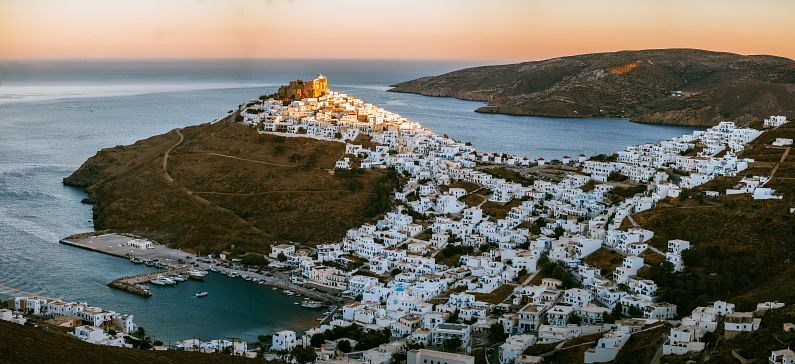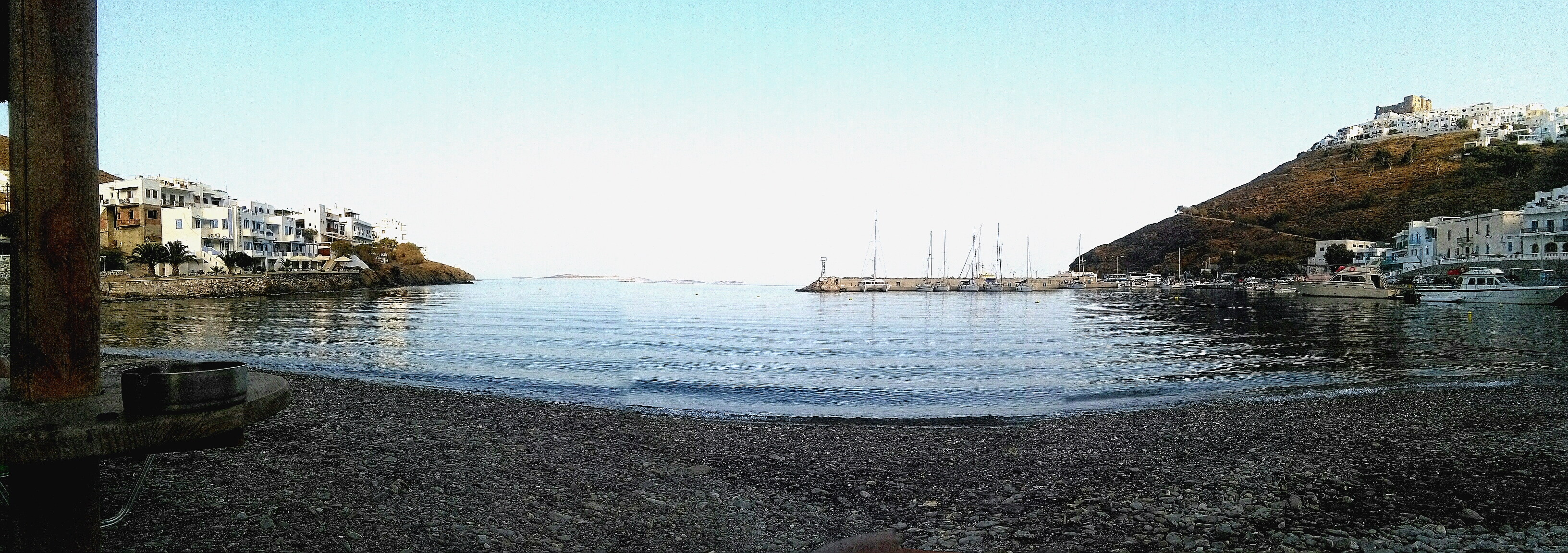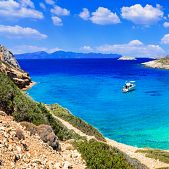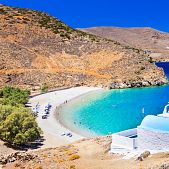
The “Butterfly of Aegean”
The “Butterfly of Aegean”, Astypalea or Astropalia, is the island whose wild beauty enchants even the most demanding visitor. The barren rocks combined with the crystal blue waters and golden beaches, create an image close to paradise as if was taken from a painting. At the same time just by looking at them, a fan of alternative vacations instantly knows that holidays there will be stress-free with moments of relaxation.
Newspapers and magazines, such as Trivago, Telegraph, Die Welt and many travel bloggers worldwide, honor and praise the island with their reviews and articles. Furthermore, in 2017, Astypalaia appeared on the tourist map of Greece, by representing the country in the world, as the ideal destination according to the American Express Essentials.
Archaeologists believe that its name, which means “Old City”, was given by its Dorian residents – who found traces that the Phoenicians were residing in that area. The island acquired other names, such as “Pyrrha” (fire), from the red color of the earth, “Gods Bank”, for the fruit and flowers with their rich aroma, and “Ichthyoessa” (abundance of fish) because of its rich with fish seas.
It is located on a major crossroad between Asia Minor, the Middle East, and Egypt and is part of the Dodecanese. Among the islets belonging to Astypalea is Zaphoras, or Grand Sofrano, which can be visited by boat from Maltezana (Analipsi) bay, and Stephania, which has been declared a Special Protection Area by the European Ecological Network NATURA 2000 for the bird species of Scopoli’s Shearwater, Eleonora’s falcon and Manx Shearwater.
The most habitable and populated area is the island’s capital, which offers the many options for dining and entertainment. Next is Maltezana, or Analipsi, next to the island’s airport. Livadi is the “flower garden” of Astypalaia, which is filled with citrus groves of mandarin, orange and grape vines and is mostly inhabited during the summer. The houses there are decorated with flowers and which are also spread across the stream, leading to one of the most beautiful and tourist exploited beaches with several cafés and restaurants. Also on the northeast side of the island, there is a tiny village called Vathi.
In the winter, the population of Astypalaia is 1,500 residents, though, throughout the summer, the occupancy climbs almost to 90%. This does not affect the Greek and foreign travelers’ fun and enjoyment, because the shops at Chora, Pera Gialos, or Old Port, are spacious with different styles, and they can accommodate, serve and please the large crowd of visitors.
One of the main attractions of the island is the South Aegean Castle of Astropalia or Castle of Quirinus, which was built by the family of Querini, in the 14th century, and it took its final shape in the 15th century. It is built with traditional local dark stone and is surrounded by white, Cycladic houses whose outer walls create another wall with small windows for loopholes. It is strongly fortified to protect the occupants from pirates, and also provides a good view of the two natural harbors of the island. Two white churches with stone bell towers stand within the castle; Castle’s Virgin (1853) and Saint George (1790).
The church of Panagia Portaitissa, or the Iviron Theotokos, rests below the castle and is the religious center of the island. From the 14th to the 16th of August, the biggest festival of the year takes place to honor her (Assumption of Mary). On the eve of the 15th of August, a traditional feast takes place with dancing in the churchyard, while the day after, locals cook “Lambrianos” (traditional Astypalaia dish, which is lamb stuffed with rice and liver). The final day, a swimming competition takes place, then “giaourtotaisma” (which means “yoghurt feeding” and is played blindfolded) and lastly the “rooster” game (locals tie a fake rooster at the edge of a wooden pillar, which is smeared with grease, and the competition lies in who will catch the cock first, while walking on the grease).
The islands Archaeological Museum is located in Chora. Its exhibition is intertemporal and includes several exceptional exhibits, which covers a wide chronological range from prehistoric times to the Middle Ages.
The renowned Baths of Talara, in Maltezana, which stand out because of the blue and terracotta mosaic of the Hellenistic period, is one of the hidden treasures of the island. They are considered to be unique in Greece and they portray the four seasons and symbols of the zodiac. Another thing that stands out in the island is the Cave of the Black, in Vatses, which has impressive formations of stalactites and stalagmites and is interwoven with myths about pirates and the loot they hid there.
As for the beaches of Astypalea, there are plenty of options both for those who seek the solitude and silence of isolation and for those who wish to stay among the crowds. The island offers crystal clear blue waters and a rich underwater world to explore, from Pera Gialos, which is the old port, up to the beach of Saint John, accessible only by sea. Full-day boat trips also arrange transfers to the beaches of Koutsomyti, Kounoupi, Vatses, and Kaminakia – some of the places that can steal one’s breath away, due to their natural beauty.
TIPS...
– The eight red mills, Astypalaia’s trademark, which beautifies Chora, are all in good use by the municipality and they host beyond – apart from being the necessary information center for tourists – small students exhibitions or of foreign artists. One of them, houses a small library that aims to collect as many Greek literary works translated into English, French, German, Italian, Spanish, Arabic, Russian and Chinese, in order to provide them to the foreign visitor.
– In March 2017, Astypalea won praise for its local cuisine, when local cooks attended the culinary event of the James Beard Foundation, one of the greatest culinary fairs in New York.
– In May 2017, it was named “ambassador” of Greece in the celebrations of Europe Day, in Brussels, since according to the legend, Europe and Astypalaia, daughters of Phoenix and Perimidis, caused the love interest of the Olympian gods. Europe seduced Zeus and her ravishing sister, Astypalea, seduced Poseidon, who, dazzled by her beauty, transformed into a sea dragon, abducted and placed her in the middle of the Aegean.
– The American Express Essentials included the island within the 41 top destinations in the world, in 2017.
– In 2016, Trivago placed it second in the list of the Top 10 Island Destinations in Europe.
– The German Die Welt wrote that “this is Astypalaia, the unknown Greek island, a little gem.”
– A group of Paleoanthropology students, under the direction of Professor Simon Chilson from the Institute of the University of London UCL, visits the island every summer to study the well-known baby cemetery. Newborn babies who died at birth or infants up to two years that passed away – according to custom – were placed in vessels to have the feeling of the uterus. The cemetery was probably close to a Sanctuary of Eileithyia, a goddess-protector of childbirth. The shrine probably lies somewhere in Chora but has not yet been revealed.
– Astypalea was among the “15 best islands in Greece” according to Conde Nast Traveller.













